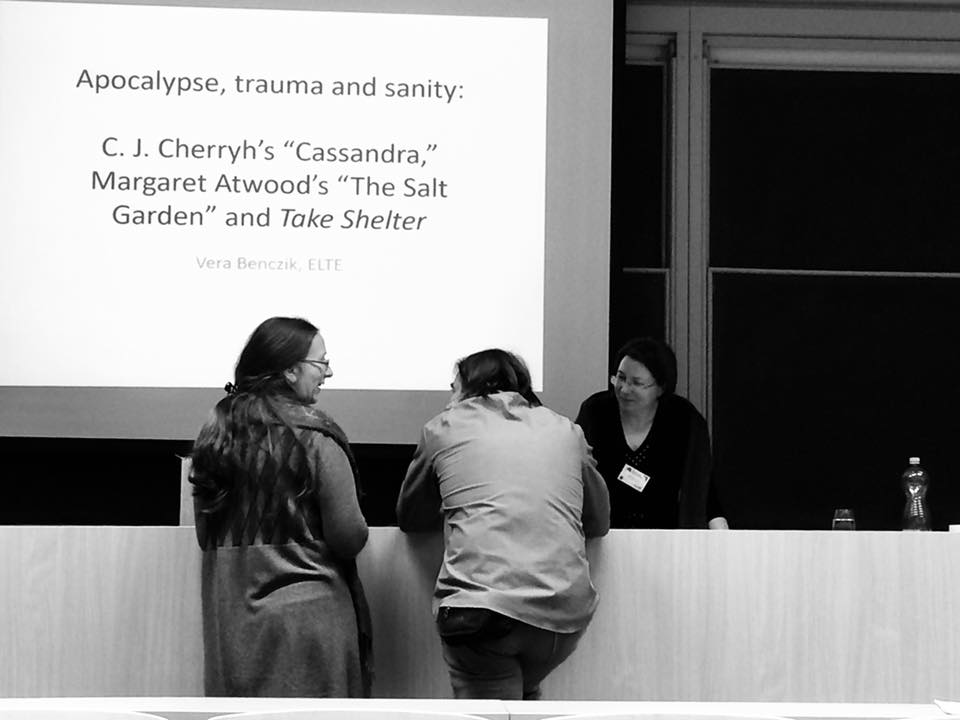 Pillanatkép a "SCI-FI, FANTASY, APOCALYPSE" szekció előtt. A képen (balról jobbra): Limpár Ildikó, Gyuris Norbert, Benczik Vera.
Pillanatkép a "SCI-FI, FANTASY, APOCALYPSE" szekció előtt. A képen (balról jobbra): Limpár Ildikó, Gyuris Norbert, Benczik Vera.
Fotó: Krausz Katinka
Kutatócsoportunk tagjai közül számosan vettek részt és adtak elő fantasztikum / popkultúra témában a két évente megrendezésre kerülő hazai HUSSE (Hungarian Society for the Study of English / Magyar Anglisztikai Társaság) konferencián. A konferenciára benyújtott angol nyelvű absztraktokból kiderül, ki milyen kutatásra fókuszál jelenleg.
Vera Benczik:
Apocalypse, trauma and sanity: C. J. Cherryh's "Cassandra," Margaret Atwood's "The Salt Garden" and Take Shelter
Narratives using the apocalypse as their setting usually either locate the plot at the time around the cataclysm, or explore how the individual and the community tries to cope in a world devastated by global catastrophe. In these stories the defamiliarized landscape of destruction acts as the new norm, and our familiar world only appears as either the pretext for the catastrophe, or outside the narrative framework, as the fictitious world's history and the audience reality.
There is one set of narratives which focuses on the apprehension of disaster, delineating a scenario in which imminent catastrophe is only anticipated by one person, dismissed as strange or even insane by his/her community. In these stories visions of the apocalypse intrude into the peace of everyday reality, generating doubt as to their credibility: C. J. Cherryh's 1976 short story "Cassandra," or the film Take Shelter (2011) operate with plots along this line, as does Margaret Atwood's short story "The Salt Garden," whose protagonist, Alma gets flashes of a coming nuclear apocalypse. In my presentation I will explore how these narratives entwine individual anxiety, questions of sanity, and intergenerational conflicts with the iconography of global destruction, using the relevant theories of E. Ann Kaplan, Alison Landsberg and Dominick La Capra.
Kinga Földváry:
The Lost Years Newly Found – Variations on the Shakespeare Myth in Contemporary Biopics
Even though Shakespeare scholarship has long been trying to dispel the idea that the scarcity of information available about the life of the Stratford Shakespeare should make us doubt his identification as the greatest dramatist in the English language, popular media keeps producing new versions of the author's life, each creator coming up with a new explanation for the unrivalled fame of Shakespeare and his oeuvre. The long-established motion-picture genre of the biopic, with its interest in the success stories of long-dead historical personalities offers the perfect visual framework for such speculative representations, as exemplified by a number of recent works as well. In my paper, I look at several such products from the last two decades, focusing on the generic features that are seemingly independent of the life discussed, while also investigating whether there are any distinctive features characterising the Shakespeare biopic, contrasting this subgroup with biographical films based on the lives of other historical figures. The films examined include the mainstream Hollywood features Shakespeare in Love (1998, dir. John Madden), and Anonymous (2011, dir. Roland Emmerich); a made-for-television biopic, A Waste of Shame (2005, dir. John McKay); a comic musical version produced by the Horrible Histories team under the title Bill (2015, dir. Richard Bracewell), and a short-lived television series entitled Will (2017, created by Craig Pearce).
Ildikó Limpár:
Growth and Empowerment: The Conscious Zombie in Daryl Gregory's Raising Stony Mayhall
By the nature of their existence, zombies are rarely associated with growth, maturation, and character development; in fact, they generally stand for disintegration and fall in a social context. Deeply rooted in the tradition that interprets zombies as the signifiers of the human condition bound by real or metaphorical slavery, the zombie of contemporary fiction has become one of the most expressive metaphors for the degenerative effects that consumer society has on the individual. However, zombie fiction has seen a new boost by the appearance of the humanized zombie, which may uncover the strange, painful, and unexpected dimension of coming of age, too. The present paper discusses how Daryl Gregory uses the zombie for expressing a growth that is incredible and that is, nevertheless made possible by the family. In Raising Stony Mayhall, the protagonist's experience of maturation emphasizes a limitation that comes with his "special condition"; his growth, nevertheless, highlights the possibility of unconventional development. Zombie coming of age, in this novel, therefore, is the signification of hope for the disprivileged—and offers also hope for society this way. Stony's existence redefines the concept of love, ableness and family for all the other family members, and the concept of disintegration for a larger community.
Dániel Panka:
Frankensteinian motifs in Kornél Mundruczó's Tender Son: The Frankenstein Project (2010) and Benedek Fliegauf's Womb (2010)
Hungarian directors Benedek Fliegauf and Kornél Mundruczó both created films inspired by Frankenstein in the same year, 2010. Fliegauf's film Womb takes a science-fictional approach and tells the story of a woman named Rebecca who gives birth to a clone of her former love interest who dies in an accident. Mundruczó's film Tender Son: The Frankenstein Project has a more realistic approach and depicts the unlikely reunion of an inexplicably violent son and his father. While the latter film explicitly evokes Frankenstein in its title and acknowledges its debt to Shelley's novel, the former does not include her name or the title of the text in any way. The paper intends to examine the Frankensteinian motifs and interpretations in these films.
Despite the differences in language and scope, the films are connected via their approach to the creator-creature dynamic and the creator's responsibility. In Womb, Victor's possessiveness and incestual fantasies are recreated between Rebecca and her son, Tommy, with the result of a break between them. Tender Son, on the other hand, emphasizes the story of the irresponsible creator who abandons his creature only to witness the destructive results of his negligence.
Mónika Rusvai:
Journey without Destination: Cyclicality of Space and Time in Robert Holdstock's Lavondyss
A sequel to the World Fantasy Award winning Mythago Wood, Lavondyss is a wonderfully complex novel that turns a forest into a living and breathing manifestation of the unconscious. In both novels, the wood creatures can be interpreted as Jungian archetypes, yet in Lavondyss, the intricate spatial and temporal structure gains an even greater significance than in the first book. In my presentation I attempt to show that in Lavondyss the perception of space and time is closely related to storytelling – one of the main themes that have an essential role in structuring the novel. Throughout the analysis, I will rely on Farah Mendlesohn's thoughts in Rhetorics of Fantasy, and prove that the core myth told in several versions (and in various spatial and temporal milieus) is on the one hand, the main fantastic intrusion that drags the young protagonist, Tallis into the unknown region, and on the other hand, it is responsible for the cyclicality of space and time that eliminates the possibility of ever truly leaving Ryhope Wood behind.
Anikó Sohár:
The Unseen University. A Representation of Academic Life in Fantasy
The representation of academic life in SFF is a very popular ancillary or episodic topic. It usually mixes two subgenres, the so-called school story with fantasy or science fiction, where the university supplies the necessary and fascinating background for the narrative. In some cases real universities gain fictitious training programmes, professors or students, for example, Oxford (the most popular university in the genre) in all Connie Willis stories on historians who use time travel as a research tool or practicum for undergraduates, in the James Asher series by Barbary Hambly, in All Souls trilogy by Deborah Harkness, in His Dark Materials trilogy by Philip Pullman, or Toronto in The Fionavar Tapestry by Guy Gavriel Kay, and Pittsburgh in Steel Rose by Kara Dalkey. However, completely made-up universities prevail in SFF for example, Butler University in Newford City (both invented by Charles de Lint), the colleges on the twin planets of Yeowe and Werel (created by Ursula K. Le Guin as part of her Hainish cycle), the University in The Kingkiller Chronicle by Patrick Rothfuss, and Armedius Academy in The Rithmatist by Brandon Sanderson, to mention but a few.
The mode of representation often criticises, even parodises academia, particularly 'academese' and the strife for positions (see Sohár 2017). Here I can only give a sample of this fascinating subject, highlighting the recurrent motifs, focusing on the famous Unseen University in the Discworld series by Terry Pratchett: how it developed throughout the series from mere parody into an important model of both inquisitive intellects and civil behaviour and what this representation of academe tells us about the general public's perception of higher education.


